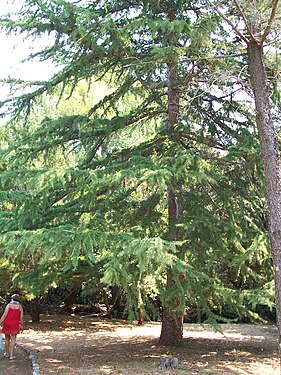Cedrus deodara
| Habit | tree
| |
|---|---|---|
| Height: | ⇕ | 40 ft"ft" can not be assigned to a declared number type with value 40. to 80 ft"ft" can not be assigned to a declared number type with value 80. |
| Lifespan: | ⌛ | perennial |
| Exposure: | ☼ | sun |
|---|---|---|
| Water: | ◍ | moderate |
| Features: | ✓ | evergreen |
| USDA Zones: | 7 to 8.5 |
|
Cedrus > |
deodara > |
Cedrus deodara (Deodar Cedar, Himalayan Cedar, or Deoda) is a species of cedar native to the western Himalayas, occurring at 1500–3200 m altitude. It is a large evergreen coniferous tree reaching 40–50 m tall, exceptionally 60 m, with a trunk up to 3 m diameter. It has a conic crown with level branches and drooping branchlets.[1]
The leaves are needle-like, mostly 2.5–5 cm long, occasionally up to 7 cm long, slender (1 mm thick), borne singly on long shoots, and in dense clusters of 20-30 on short shoots; they vary from bright green to glaucous blue-green in colour. The female cones are barrel-shaped, 7–13 cm long and 5–9 cm broad, and disintegrate when mature (in 12 months) to release the winged seeds. The male cones are 4–6 cm long, and shed their pollen in autumn.[1]
t is widely grown as an ornamental tree, much planted in parks and large gardens for its drooping foliage. General cultivation is limited to areas with mild winters, with trees frequently killed by temperatures below about −25 °C, limiting it to hardiness zones 8 and warmer for reliable growth.[2] It is commonly grown in western Europe (north to Scotland), in the Mediterranean region, around the Black Sea, in southern and central China, on the west coast of North America as far north as Vancouver, British Columbia, in the southeastern United States from Texas to Virginia, and in South Africa.
The most cold-tolerant trees originate in the northwest of the species' range in Kashmir and Paktia Province, Afghanistan. Selected cultivars from this region are hardy to zone 7 or even zone 6 [USDA zone, UK zone, which one?], tolerating temperatures down to about −30 °C.[2] Named cultivars from this region include 'Eisregen', 'Eiswinter', 'Karl Fuchs', 'Kashmir', 'Polar Winter', and 'Shalimar'.[3][4] Of these, 'Eisregen', 'Eiswinter', 'Karl Fuchs', and 'Polar Winter' were selected in Germany from seed collected in Paktia; 'Kashmir' was a selection of the nursery trade, whereas 'Shalimar' originated from seeds collected in 1964 from Shalimar Gardens, India (in the Kashmir region) and propagated at the Arnold Arboretum.[3]
Cultivation
Propagation
Pests and diseases
Varieties
Gallery
References
- ↑ 1.0 1.1 Farjon, A. (1990). Pinaceae. Drawings and Descriptions of the Genera. Koeltz Scientific Books ISBN 3-87429-298-3.
- ↑ 2.0 2.1 Ødum, S. (1985). Report on frost damage to trees in Denmark after the severe 1981/82 and 1984/85 winters. Hørsholm Arboretum, Denmark.
- ↑ 3.0 3.1 Welch, H., & Haddow, G. (1993). The World Checklist of Conifers. Landsman's ISBN 0-900513-09-8.
- ↑ Krüssmann, G. (1983). Handbuch der Nadelgehölze, 2nd ed. Paul Parey ISBN 3-489-62622-2 (in German).
External links
- w:Cedrus deodara. Some of the material on this page may be from Wikipedia, under the Creative Commons license.
- Cedrus deodara QR Code (Size 50, 100, 200, 500)






